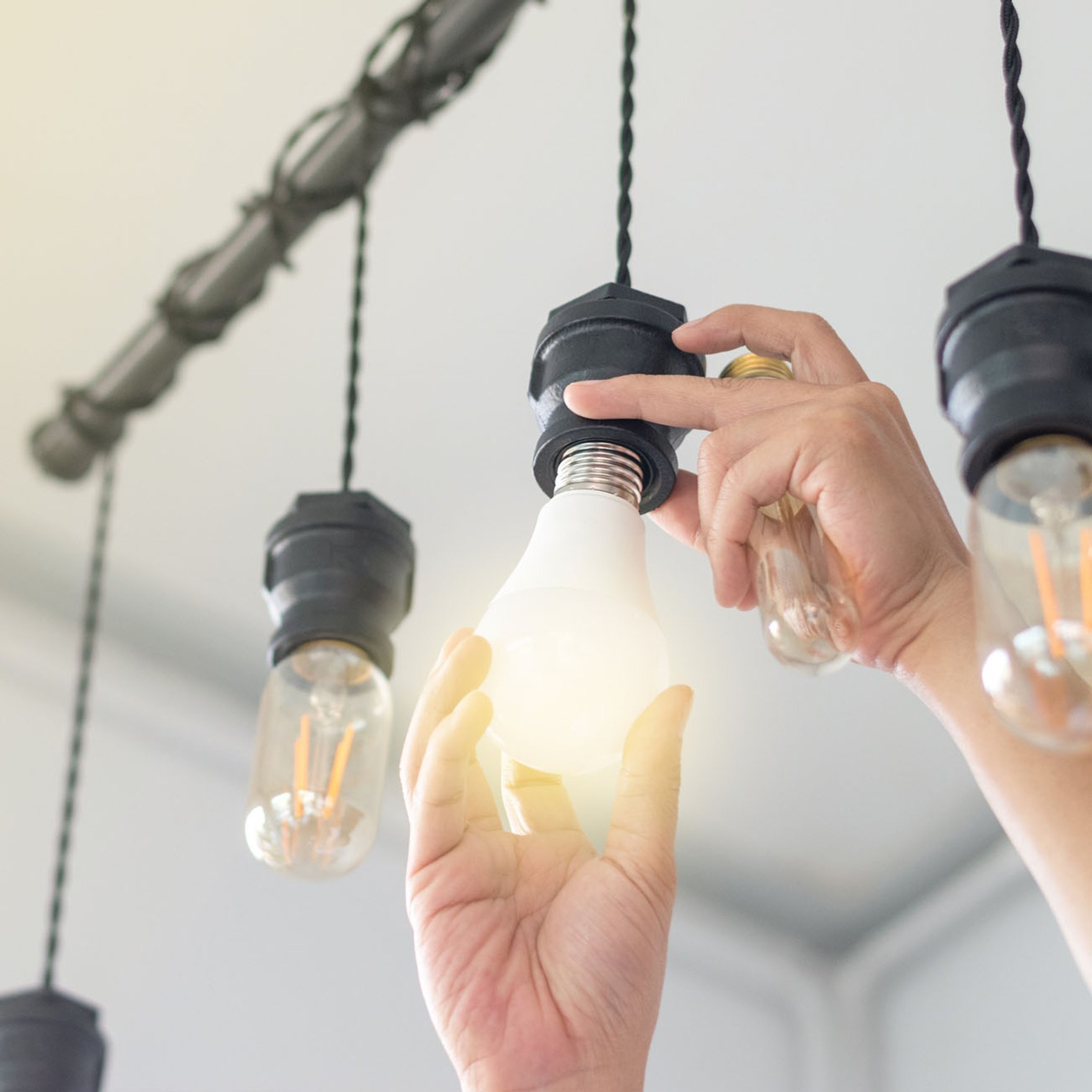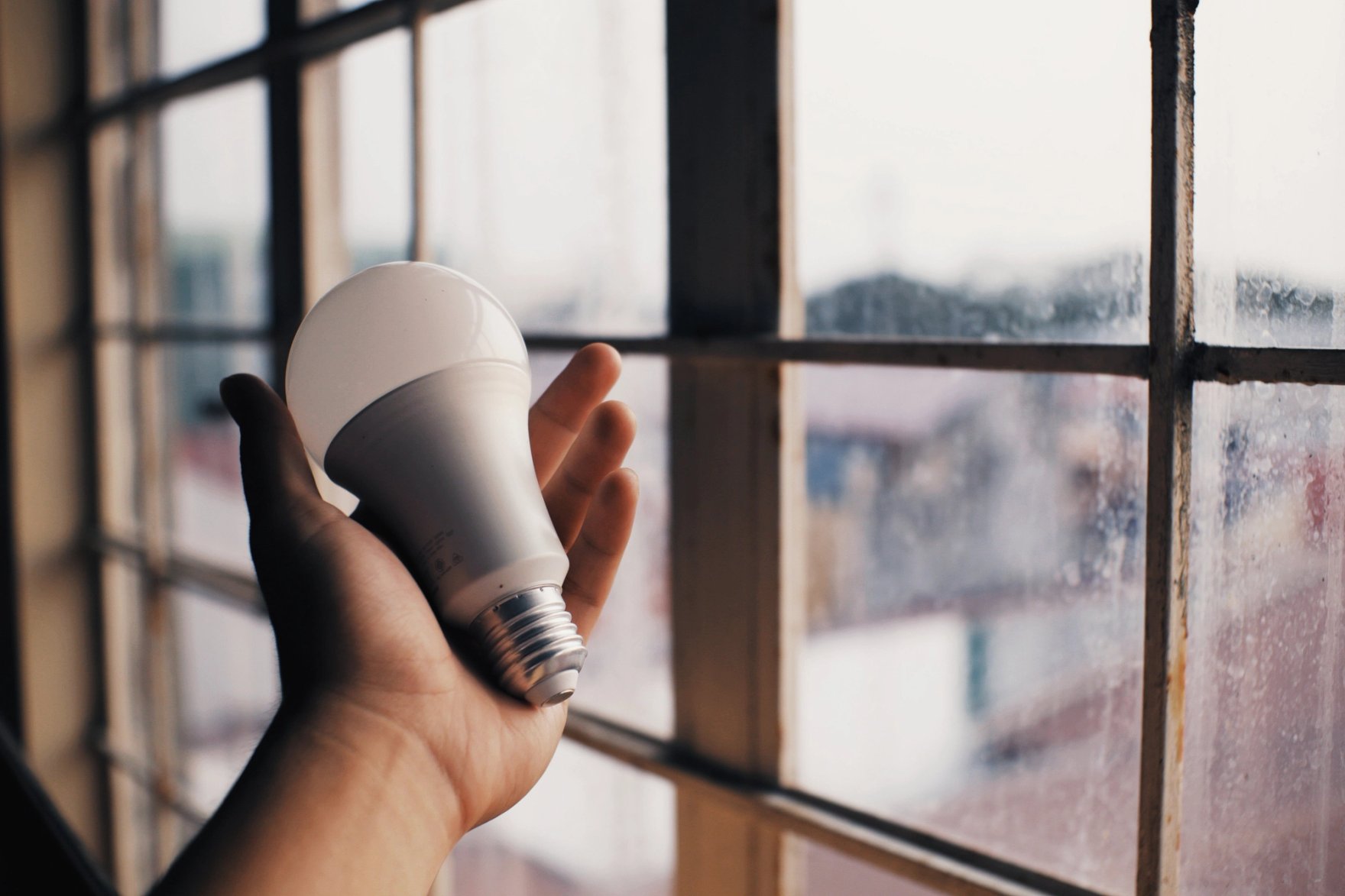If you’ve been thinking about making your home more energy efficient, starting with your lightbulbs is a great first step. Swapping out your traditional incandescent bulbs for a more energy-efficient option is a minor home adjustment that doesn’t come at a steep upfront cost. Changing out your lightbulbs can help you save on electricity costs and optimize your energy usage. We’re going to dive into two popular energy-efficient options—CFLs (compact fluorescent lamps) and LEDs (light emitting diodes) and explore their pros and cons while comparing them with the traditional incandescent bulb. Let’s begin by breaking down how these two types of energy-efficient light bulbs work.

How do CLF Bulbs Work?
The way CFLs vs LEDs produce light is one of their primary differences. CFLs are fluorescent light bulbs with spiral tubes. These spiral tubes contain mercury and argon, which are key to how the lightbulbs work. These light bulbs have a warmup period when they are switched on. During this warmup period, the electricity runs through the tube, interacting with mercury and argon to generate UV light. When this UV light hits the fluorescent interior of the tube, it begins to create light that is visible to the human eye. This process takes a few minutes to reach full capacity, but once it has, the light glows brightly.

How do LEDs Work?
LEDs operate differently than CFL light bulbs. When an LED light is switched on, an electrical current gets sent through a microchip known as the diode. When this happens, light is emitted. This process is much more immediate than that of the CFL light bulb and doesn’t require any warmup period. Both of these light bulbs have their own unique features and come at different price points. Before we explore these, let’s first understand the importance of energy-efficient light bulbs and why it can be valuable to transition to using them.
The Benefits of Energy-Efficient Light Bulbs
There are notable cost-saving and environmental impacts that come with using energy-efficient light bulbs such as CFLs and LEDs because they use less energy to produce the same amount of light. By using less energy, these lightbulbs indirectly reduce your electricity costs while simultaneously reducing the environmental impact of powering your home. They are cost-effective and energy conscious! Of course, different energy-efficient light bulbs offer different pros and cons, so let’s compare CFL vs LED energy-efficient lightbulbs with regard to their energy efficiency, longevity, light quality, and cost to assess which might be the best option for your unique needs.
Energy Efficiency
One of the most important factors to consider when it comes to making bright light bulb choices is the energy efficiency of a light bulb. Efficient, energy-saving light bulbs can help save you money on your electric costs and are generally a more planet-friendly option. LED lightbulbs are usually going to be your best bet on the efficiency front. They typically use 75% less energy than traditional incandescent bulbs! CFLs also use around 75% less energy than incandescent bulbs, but they lose to LEDs in the efficiency category because a lot of this energy is used to generate heat. LEDs, on the other hand, remain cool, allowing the vast majority of the energy to be used for light production.
Longevity
Changing out light bulbs is the worst, so longevity is also a priority. LED lightbulbs win out in this category as well, which is why they are often the go-to choice for commercial spaces. CFL or fluorescent bulbs typically last for 10,000 hours. This is a significant improvement over traditional incandescent bulbs, which only last 1,000 hours, but their lifespan still dims in comparison to LED bulbs which last for 25,000 on average! To contextualize these lifespans, a standard incandescent bulb could be on for around a month and a half non-stop before burning out. Comparatively, fluorescent bulbs could be on for just over 13 months without burning out. And the winner in the longevity category, LED bulbs could be on for about 3 years before burning out.
Light Quality
Of course, it’s not just about efficiency and longevity. If you’re selecting bulbs to illuminate your home, you want to ensure they provide an inviting glow. This is often where energy-efficient lightbulbs are met with some hesitation, but let’s take a look at how the energy-efficient options measure up. When comparing LED vs fluorescent bulbs, one of the first considerations is the CFL “warm up” period. These bulbs take some time to warm up, which is far from ideal when needing immediate illumination. Conversely, LEDs turn on instantaneously, making them an optimal choice. However, LEDs are known to produce somewhat harsher and cooler tone light as compared to CFLs which are known to be a bit warmer and softer. However, in recent years more warm-tone LEDs have hit the market, allowing for lighting tones. Given the energy efficiency and longevity benefits of LEDs, we’d say they’re worth the slightly harsher light and can only assume that as time goes on, more and more soft and warm options will become available.
Cost
When thinking about the cost of a light bulb, it’s not just the cost of the box on the shelf that matters. It’s also the cost of running those bulbs and how long each one is going to last you. While it can be tempting to conclude that standard incandescent bulbs are the cheapest option based on shelf price, this does not take into consideration that they use more energy and burn out much faster. What they offer in discounted shelf price, they make up for in operating and replacement costs. Although the average cost per bulb sits at just $1, according to ViriBright, the estimated cost over 20 years comes out to around $211.
CFLs stand somewhere between LEDs and incandescent bulbs in terms of price. The average cost per bulb is $2, however, the estimated 20-year cost is only $54, a fraction of that of incandescent bulbs. This is because of the light bulb’s longer lifespan and the reduction in energy costs that comes from using a more efficient bulb.
LED lights are going to be the most cost-effective option but with the highest up-front investment. The average cost of an LED lightbulb is $4, which can deter people from purchasing them, despite all the benefits. However, we encourage you to consider the benefits the next time you’re at the store. The estimated cost over 20 years for an LED bulb is only $34, making them well worth the higher shelf price.

The clear winner in our eyes in the battle between CFLs vs LEDs is the LED light bulb! This is THE energy-efficient lightbulb. These lightbulbs will help you reduce your energy usage and subsequent costs while providing your home with bright, instant light. So, the next time a lightbulb burns out in your house, and you find yourself wandering past rows and rows of options at the hardware store, consider making the switch to LEDs—your wallet and the planet will thank you!